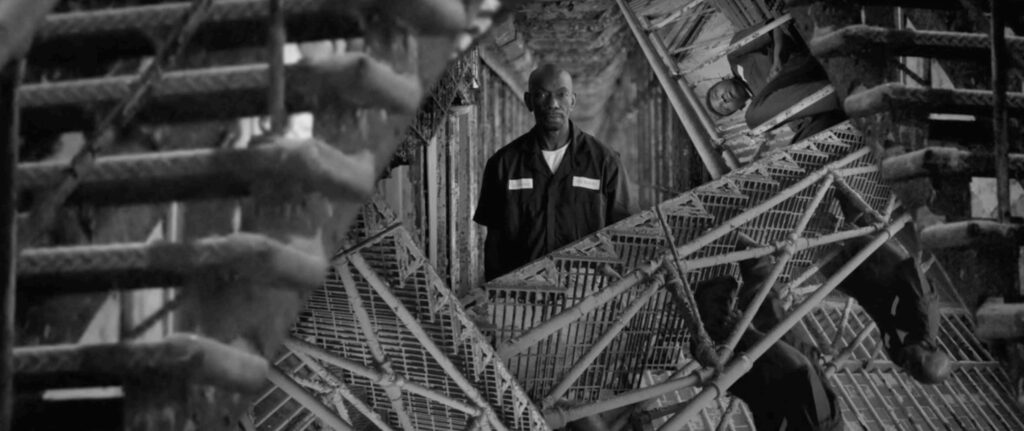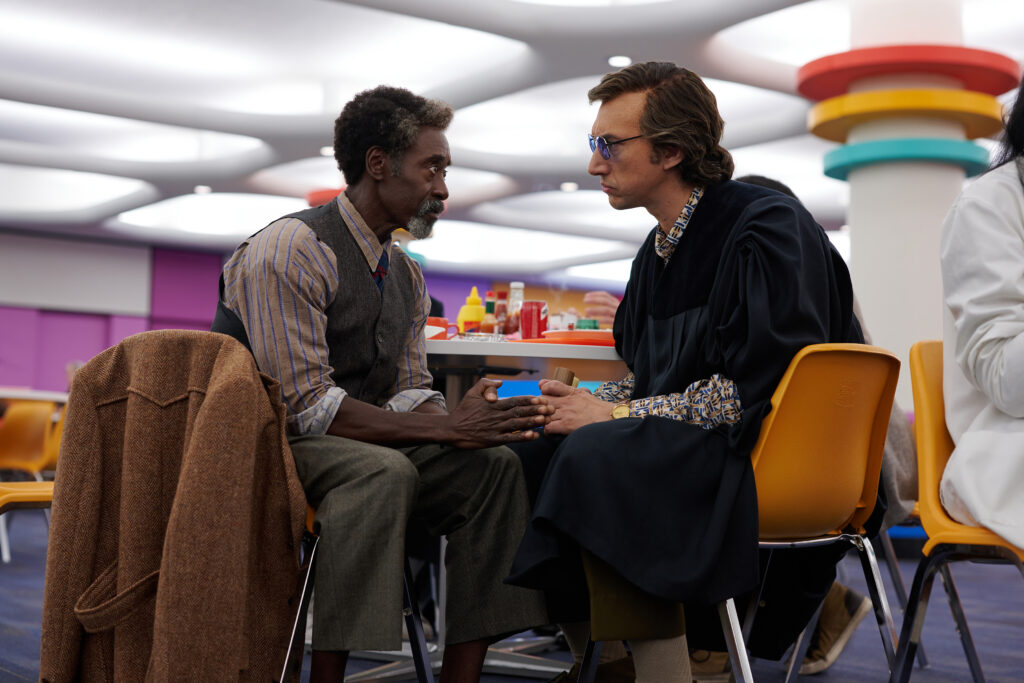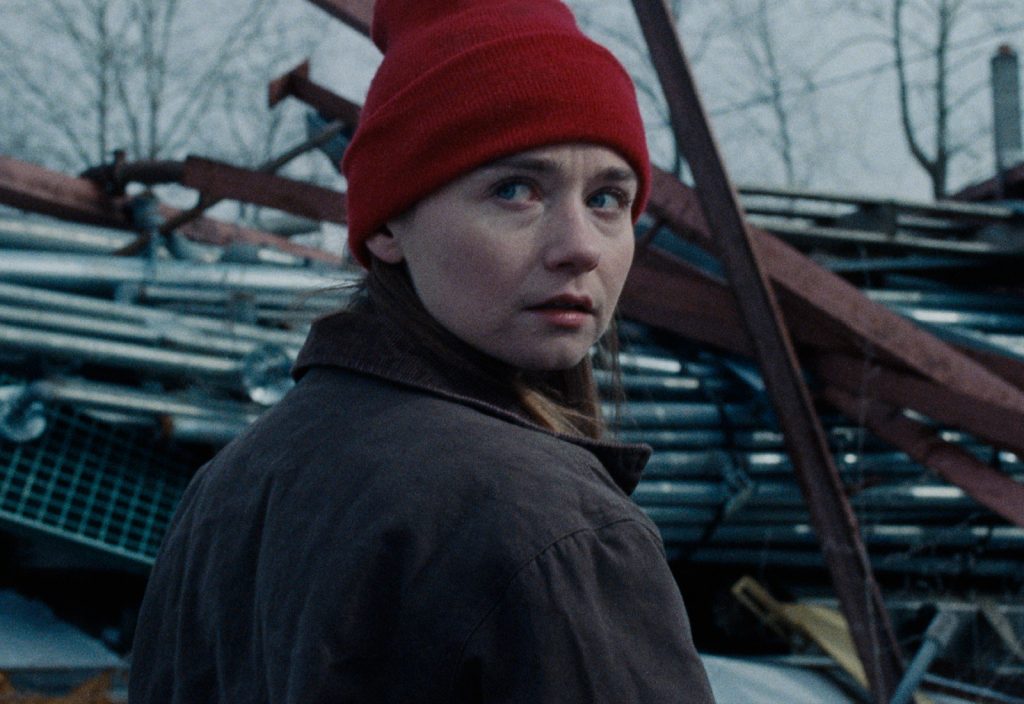December 12, 2022
by Carla Hay

Directed by Matt Waldeck
Culture Representation: The true crime documentary “Lovely Jackson” features a group working-class and middle-class African American and white people discussing the case of Rickey Jackson, who spent 39 years in prison for a 1975 murder in Cleveland that he did not commit.
Culture Clash: Jackson and several people connected to the case talk about his struggles to prove his innocence and how racism played a role in his conviction.
Culture Audience: “Lovely Jackson” will appeal primarily to people who are interested in documentaries about wrongful imprisonments and racial injustice.

“Lovely Jackson” is an example of a true crime movie that not only shines a light on a tragic failure in the U.S. criminal justice system but also offers a beacon of hope for people who are seeking justice. Rickey Jackson tells his story of being wrongfully convicted and imprisoned for murder in this artfully directed and riveting documentary. In May 1975, money order collector Harold J. Franks was shot to death during a robbery of a convenience store in Cleveland. The truth about who committed thes crimes has been at the center of various different trials and a lot of controversy.
In August 1975, Jackson (who was 18 years old at the time) was found guilty of these crimes in a jury trial. The prosecution’s main evidence was testimony from Edward “Ed” Vernon, an acquaintance of Jackson’s, who named Jackson as the shooter, even though Jackson had an alibi when the robbery/murder took place. A .38 caliber gun was used in the shooting, but this type of gun was never linked to Jackson. In December 1975, Jackson was sentenced to death.
Jackson was also convicted of attempted murder because Anna Robinson, the wife of the store’s owner, was shot during the robbery, but she survived. Wiley Bridgeman and his brother Ronnie Bridgeman (who now goes by the name Kwame Ajamu) were convicted of being Jackson’s accomplices in these crimes. The Bridgeman brothers also proclaimed their innocence in these crimes. At the time of these convictions in 1975, Wiley was 21, while Ronnie was 24.
Jackson always maintained his innocence, but he stayed in prison for 39 years. He has a remarkable story that won’t be fully revealed in this review, in case people don’t know what happened during his arduous fight to prove his innocence. Even though the outcome of the case is extraordinary, “Lovely Jackson” never lets viewers forget that what isn’t so remarkable or extraordinary are the untold numbers of wrongly convicted people who are in prison and can’t get the help or justice that they need.
Directed by Matt Waldeck, “Lovely Jackson” is a documentary that has some re-enactments that appear almost like dream sequences. Jackson serves as the main narrator of the story, while the documentary also includes interviews with people who know Jackson and are connected to his case in some way. The movie is in black-and-white during the bleakest parts of the story and switches to color for certain interviews and archival footage when the story takes some twists and turns.
Jackson tells harrowing tales of what life was like in prison, including the vicious beatdowns he witnessed, the tricky tightrope of navigating social alliances among criminals, and shutting down emotionally as a means of survival. He says he adopted this attitude in prison: “I don’t give a fuck. I’ll do whatever it takes. Don’t bother me. That’s the attitude that I had to have to survive in there.”
How did Jackson end up in this awful nightmare? According to interviews in the documentary and court testimony, Vernon (who was 12 years old in 1975) saw Jackson and some friends among the curious bystanders who showed up at the crime scene after the robbers/murderers got away. Vernon came forward as a witness. And in the police interrogation room, Vernon named Jackson and the Bridgeman brothers as the culprits, even though there was no physical evidence linking these three men to the crimes.
Jackson lost more than his freedom during his time in prison. He says that his family members stopped visiting him and communicating with him after a while, until he had no visitors or communication from any family or friends for nearly 25 years while he was in prison. He says that this estrangement wasn’t because his loved ones believed he was guilty.
Jackson thinks it was because it was too painful for them to see him in prison for crimes he didn’t commit, and avoiding him was the best way that they knew how to get on with their lives. He comments, “I never wanted anyone to put their life on hold for me because I was in prison. I just wanted them to not forget about me.”
Jackson breaks down and cries at the memory of when the police came to his family’s home to arrest him. His family was dragged outside, rounded up like criminals, and forced to do whatever the police told them to do. Jackson says tearfully, “Just seeing that there did something bad to me … That feeling of helplessness.” He also describes in detail the police brutality he went through in the investigation, where he was punched so hard that he lost consciousness. He remembers the police using a buffer when assaulting him so that their punches wouldn’t leave visible injuries.
Even with all this abuse and degradation, Jackson refused to make a false confession. In 1978, Jackson was among 53 inmates in Ohio whose death sentences were vacated and changed to life in prison. During all of his parole board hearings, Jackson refused to say he was guilty. During his long and torturous appeal process to get a new trial, Jackson also refused any plea bargain where he would have to plead guilty, even if it meant that he would be released from prison earlier than expected.
Jackson also talks about how he used his time in prison to educate himself and find ways to get his appeals heard by the right people. It was never easy, of course, because he dealt with many years of rejections and false hope. At times, it felt like he was in a very lonely battle for his freedom, since many of his early supporters faded away and seemed to forget about him. It’s a heartbreaking reality for many innocent people who are in prison for crimes they didn’t commit.
The re-enactments and dreamlike sequences in “Lovely Jackson” are all in black and white. Some of the sequences show Jackson screaming in slow-motion while describing some of his moments of deepest despair. He talks about his bouts with depression. Jackson also appears in some flashback scenes as an observer to what his life was like in the past. The actors who appear in these re-enactments and dreamlike sequences include Mario Beverly as a young Jackson, Devito Parker Jr. as a young Vernon, and Dijon Kirkland as Jackson’s beloved mother.
What’s even more compelling than the re-enactments is the story of what happened in real life. Even though there aren’t a lot of people interviewed in the documentary (a wise choice since this movie didn’t need too many talking heads), “Lovely Jackson” has a fairly well-rounded group of people who are interviewed. What’s also impressive is how candid the interviewees are in the documentary.
Karen Smith, the only eyewitness to the murder, blasts the prosecution for not calling her as a witness in Jackson’s first trial. Mary McGrath, assistant county prosecutor of Ohio’s Marion County, had a vested interest in not letting Vernon’s conviction be overturned, even though she wasn’t part of Jackson’s first trial. In “Lovely Jackson,” McGrath admits that Smith’s testimony was more important than any recantation that Vernon (the prosecution’s star witness) might have made.
A remorseful Vernon does a sit-down interview where he discusses feeling guilty about being the main reason why three innocent people were sent to prison. He says that the police put pressure on him to name people as the culprits, and that the police weren’t concerned finding any evidence against the people he named. Vernon opens up about having suicidal thoughts when he was younger because he felt so ashamed of his role in these wrongful convictions.
It’s mentioned several times in the documentary that Jackson being African American had a lot do with the raw deal that he got in a criminal justice system that tends to gives worse punishments to people of color for the same crimes that white people commit. Jackson’s working-class background also affected his ability to get good legal representation in a case that should never have resulted in him being indicted, due to the lack of evidence.
One of the best things about “Lovely Jackson” is how it shows the heroes who helped Jackson in his quest for justice. Anthony Singleton, a pastor in Cleveland, was instrumental in getting Vernon to recant his original testimony about Jackson, after years of Vernon refusing to publicly comment on the case. The documentary includes an emotionally impactful scene with Singleton and Vernon demonstrating how Vernon had a change of heart.
Ohio Innocence Project co-founder Mark Godsey and defense attorney Brian Howe (who was Jackson’s co-counsel during Jackson’s second trial) are also interviewed and give vivid details about the appeals process and the massive amount of work (and numerous setbacks) during this process. Another of Jackson’s champions who came along later in Jackson’s life is his wife Clarissa Jackson, who is one of the documentary’s interviewees. The documentary is named after their daughter Lovely Jackson.
“Lovely Jackson” had its world premiere at the 2022 American Black Film Festival. In 2022, the documentary was also screened at the Montreal International Black Film Festival, the Red Rock Film Festival and San Diego International Film Festival. It’s the type of memorable movie that should have a chance to be seen by more people. Rickey Jackson’s story has a lot of tragedy, but it’s also a remarkable and inspirational testament to the power of never giving up during seemingly impossible odds.






